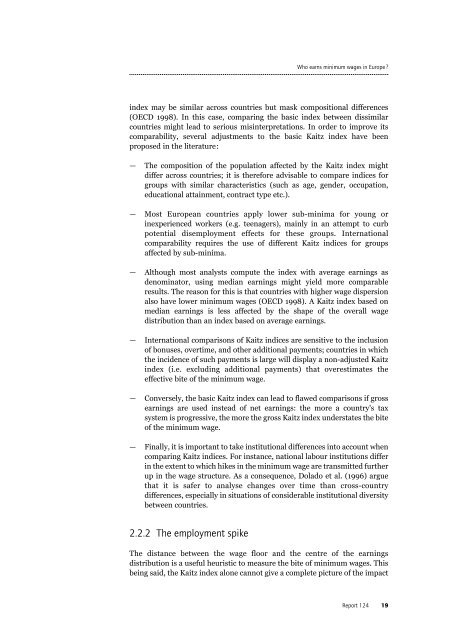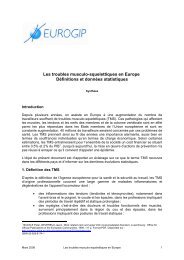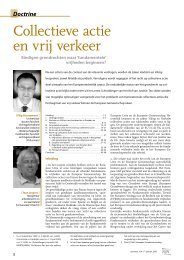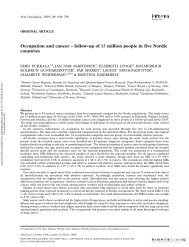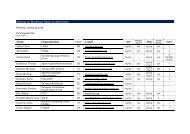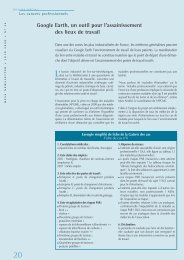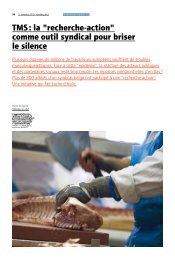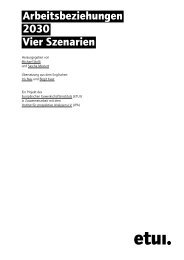Who earns minimum wages in Europe - European Trade Union ...
Who earns minimum wages in Europe - European Trade Union ...
Who earns minimum wages in Europe - European Trade Union ...
You also want an ePaper? Increase the reach of your titles
YUMPU automatically turns print PDFs into web optimized ePapers that Google loves.
<strong>in</strong>dex may be similar across countries but mask compositional differences<br />
(OECD 1998). In this case, compar<strong>in</strong>g the basic <strong>in</strong>dex between dissimilar<br />
countries might lead to serious mis<strong>in</strong>terpretations. In order to improve its<br />
comparability, several adjustments to the basic Kaitz <strong>in</strong>dex have been<br />
proposed <strong>in</strong> the literature:<br />
— The composition of the population affected by the Kaitz <strong>in</strong>dex might<br />
differ across countries; it is therefore advisable to compare <strong>in</strong>dices for<br />
groups with similar characteristics (such as age, gender, occupation,<br />
educational atta<strong>in</strong>ment, contract type etc.).<br />
— Most <strong>Europe</strong>an countries apply lower sub-m<strong>in</strong>ima for young or<br />
<strong>in</strong>experienced workers (e.g. teenagers), ma<strong>in</strong>ly <strong>in</strong> an attempt to curb<br />
potential disemployment effects for these groups. International<br />
comparability requires the use of different Kaitz <strong>in</strong>dices for groups<br />
affected by sub-m<strong>in</strong>ima.<br />
— Although most analysts compute the <strong>in</strong>dex with average earn<strong>in</strong>gs as<br />
denom<strong>in</strong>ator, us<strong>in</strong>g median earn<strong>in</strong>gs might yield more comparable<br />
results. The reason for this is that countries with higher wage dispersion<br />
also have lower <strong>m<strong>in</strong>imum</strong> <strong>wages</strong> (OECD 1998). A Kaitz <strong>in</strong>dex based on<br />
median earn<strong>in</strong>gs is less affected by the shape of the overall wage<br />
distribution than an <strong>in</strong>dex based on average earn<strong>in</strong>gs.<br />
— International comparisons of Kaitz <strong>in</strong>dices are sensitive to the <strong>in</strong>clusion<br />
of bonuses, overtime, and other additional payments; countries <strong>in</strong> which<br />
the <strong>in</strong>cidence of such payments is large will display a non-adjusted Kaitz<br />
<strong>in</strong>dex (i.e. exclud<strong>in</strong>g additional payments) that overestimates the<br />
effective bite of the <strong>m<strong>in</strong>imum</strong> wage.<br />
— Conversely, the basic Kaitz <strong>in</strong>dex can lead to flawed comparisons if gross<br />
earn<strong>in</strong>gs are used <strong>in</strong>stead of net earn<strong>in</strong>gs: the more a country's tax<br />
system is progressive, the more the gross Kaitz <strong>in</strong>dex understates the bite<br />
of the <strong>m<strong>in</strong>imum</strong> wage.<br />
— F<strong>in</strong>ally, it is important to take <strong>in</strong>stitutional differences <strong>in</strong>to account when<br />
compar<strong>in</strong>g Kaitz <strong>in</strong>dices. For <strong>in</strong>stance, national labour <strong>in</strong>stitutions differ<br />
<strong>in</strong> the extent to which hikes <strong>in</strong> the <strong>m<strong>in</strong>imum</strong> wage are transmitted further<br />
up <strong>in</strong> the wage structure. As a consequence, Dolado et al. (1996) argue<br />
that it is safer to analyse changes over time than cross-country<br />
differences, especially <strong>in</strong> situations of considerable <strong>in</strong>stitutional diversity<br />
between countries.<br />
2.2.2 The employment spike<br />
<strong>Who</strong> <strong>earns</strong> <strong>m<strong>in</strong>imum</strong> <strong>wages</strong> <strong>in</strong> <strong>Europe</strong> ?<br />
The distance between the wage floor and the centre of the earn<strong>in</strong>gs<br />
distribution is a useful heuristic to measure the bite of <strong>m<strong>in</strong>imum</strong> <strong>wages</strong>. This<br />
be<strong>in</strong>g said, the Kaitz <strong>in</strong>dex alone cannot give a complete picture of the impact<br />
Report 124<br />
19


